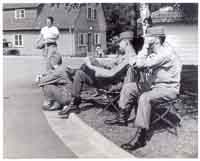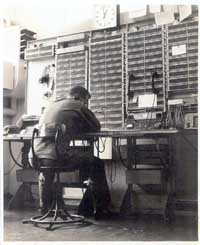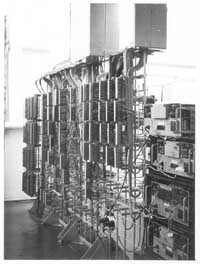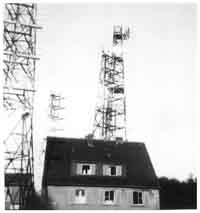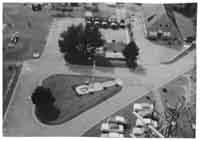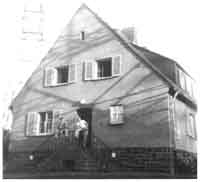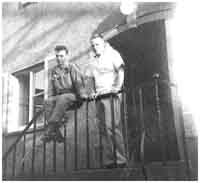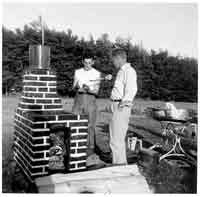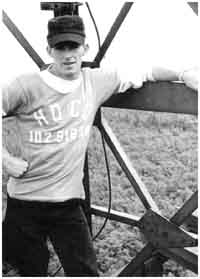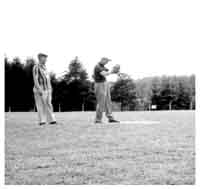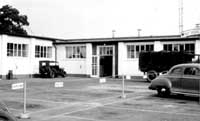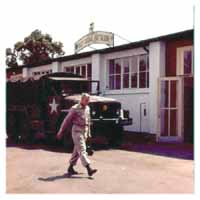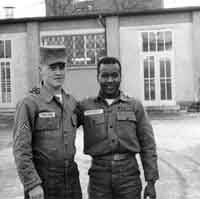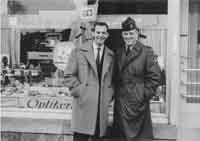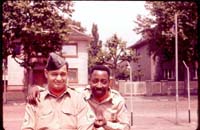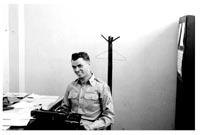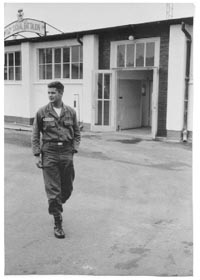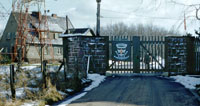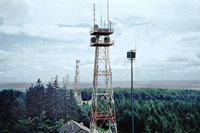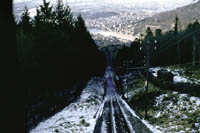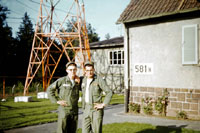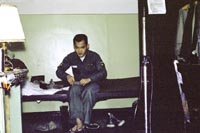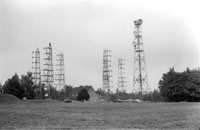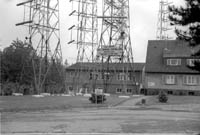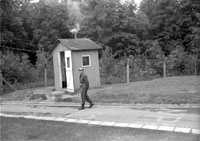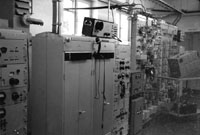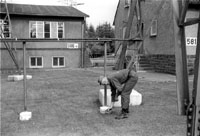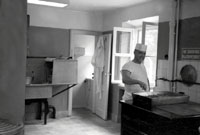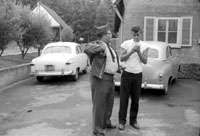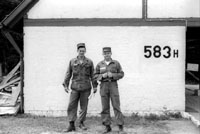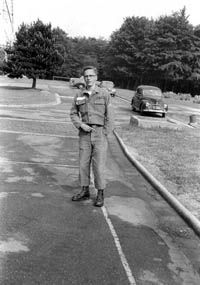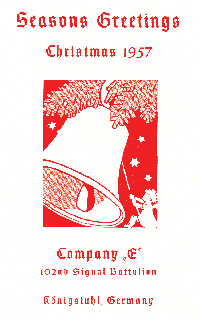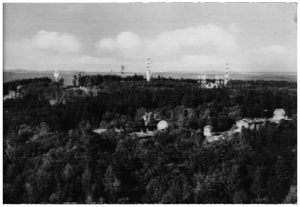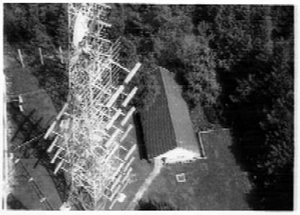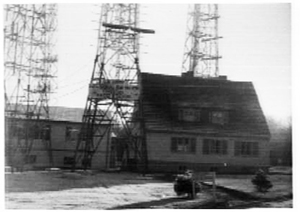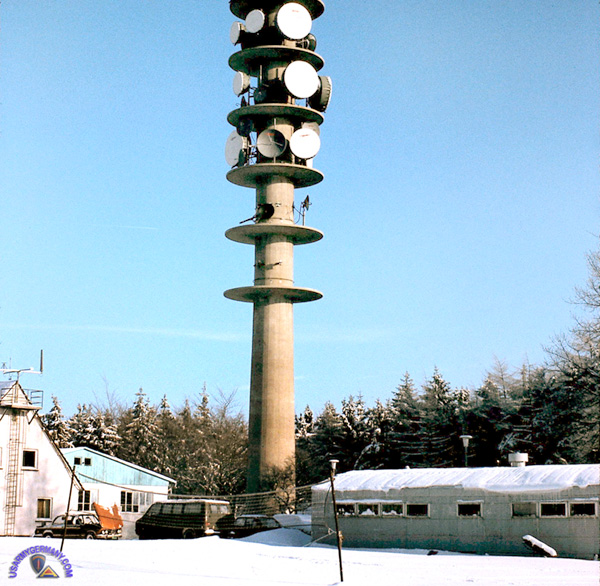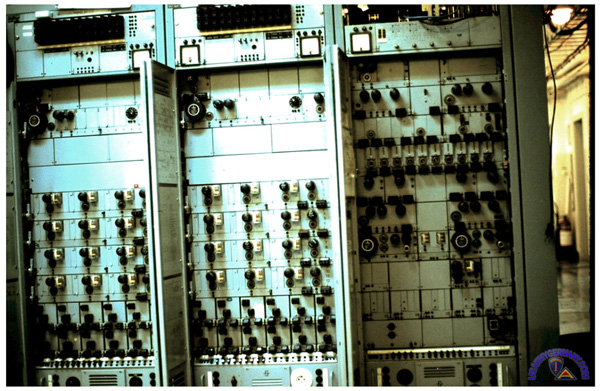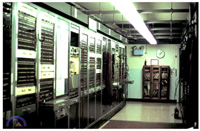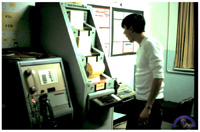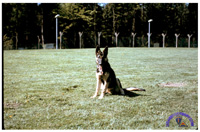| If you do
NOT see the Table of Contents frame to the left of this page, then
Click here to open 'USArmyGermany' frameset |
|||||||||||||||||||||||||||||||||||||
|
Koenigstuhl Radio Station |
|||||||||||||||||||||||||||||||||||||
|
|
|||||||||||||||||||||||||||||||||||||
|
|||||||||||||||||||||||||||||||||||||
|
|
|||||||||||||||||||||||||||||||||||||
| Koenigstuhl Radio Station | |||||||||||||||||||||||||||||||||||||
|
|||||||||||||||||||||||||||||||||||||
| 4th Signal Service Group | |||||||||||||||||||||||||||||||||||||
| 1953 | |||||||||||||||||||||||||||||||||||||
| (Source: STARS & STRIPES, July 29, 1953) | |||||||||||||||||||||||||||||||||||||
| The Koenigstuhl VHF Radio Telephone Station is a vital link in the radio telephone communications in USAREUR. The site is operated by a detachment of 50 men - specialists selected from various units: All of these units are subordinate to the 4th Sig Svc Gp, commanded by Lt Col M.W. Embury. |
|||||||||||||||||||||||||||||||||||||
| 102nd Signal Battalion | |||||||||||||||||||||||||||||||||||||
| 1954 | |||||||||||||||||||||||||||||||||||||
| (Email from Hank Bartosik, 102nd Signal Battalion at Königstuhl radio site, 1954-55) | |||||||||||||||||||||||||||||||||||||
| Hank arrived
at Smiley Barracks, Karlsruhe sometime around August 1954. The unit
at that time was still known as the 315th Signal
Construction Bn. Hank spent about two months at Smiley
for retraining. Shortly after being assigned to the radio site at
Heidelberg (Königstuhl), the Battalion was redesigned as the
102nd Signal Bn. Hank still has a copy of leave papers for July of
1955 that stated that he was in Hq & Hq MW&RR 102nd. Hank was in Heidelberg
from November 1954 -September 1955. Hank has several photos of the radio station, because he spent his time with a camera and at the photo labs. The photos below show the set up inside of the station and the outside during one of many daily volleyball games. Webmaster Note: The 102d Signal Battalion (Microwave & Radio Relay) was activated on 18 March 1955 at Smiley Barracks, Karlsruhe, West Germany. The Battalion was assigned the mission of installation, maintenance and operation of the United States Army, Europe, Multi-Channel Radio Telephone Network. The gate guards at the radio site were hired from the displaced persons. I was told that they would eventually be able to enter the U.S. as citizens, having thus served in the U.S. Army. I befriended an elderly Polish guard who had been a prisoner of the Germans. I spoke a broken, dialect of Slovak and some German learned from high school, and we barely understood one another. When I arrived, there were about 30 assigned to the station, and I think that when I left a year later, there were over 50. It was easy to go off to your room and read for a couple of hours! I think that Heidelberg became the training station instead of Karlsruhe, where I spent two months of training after Fort Monmouth, New Jersey. The Day Room was off limits during the day, a constant controversy, but one way to control the "goof-offs", I suppose. Once you were on a shift, it stayed that way until you left. We only saw others during our meals, and then not everyone because if you worked the "grave yard shift" it was not unusual to sleep past lunch hour. Many fellows were off base on their days off, especially the days between the "grave yard" and the normal day shifts. We would forge passes and have coverage during our last day on the mid night shift so we would leave early in the morning and be off base until we reported for the next 8 A. M. shift. This gave us three to four day "passes" every three weeks, that would fall during the weekday and occasionally on a weekend. It was really tough to have a social life with a local girl! |
|||||||||||||||||||||||||||||||||||||
| Our station became a sort of show case, since many high ranking officers were constantly on the scene and the presence of "locals" in the station quickly abated. I was told that in the past years it was not unusual to find a girl sleeping in your bunk on a Saturday night when you arrived with the late "run" from the town. The station was on a very popular walking-hiking trail and it was not unusual for some young girls to have missed their ride down the mountain with the Zugbahn, so I was told. A 3/4 ton vehicle used to make a late night run, around midnight at the foot of the Koenigstuhl, somewhere near or at the first entrance or first stop of the Zugbahn, cable car that operated on the mountain. Sometimes we would get a frantic call from a fellow who missed that run, and we, "unauthorized", took a Jeep down to pick him up. This was particularly tricky in the winter months if it snowed during the night, no one plowed until daylight! In 1955 I purchased a new blue convertable Volkswagon and was often called upon- especially when I was on the night shift- to go down and pick up someone. They always paid for more than my gas- which was still less than the fare of the Mercedes taxis! | |||||||||||||||||||||||||||||||||||||
|
|
|||||||||||||||||||||||||||||||||||||
| 1955 | |||||||||||||||||||||||||||||||||||||
| (Source: STARS & STRIPES, June 2, 1955) | |||||||||||||||||||||||||||||||||||||
| The USAREUR Multi-channel Radio & Telephone Network consist of 46 stations spanning the US installations in Germany and western France. The network, operated by the 102nd Sig Bn, provides microwave communications to all major Army headquarters in Europe. The 102nd Sig Bn is made up of small detachments that serve at each of the stations that make up the entwork. ost are located at isolated realy points. others are found at Army kasernes, and a few are large enough to be posts in themselves. Microwave (UHF and VHF) is used by the Army to supplement commercial wires and landlines. Telephone calls go by wire to the nearest terminal station were they are bundled with other calls to a radio signal on a certain frequency. Each freqency can carry up to 24 telepnoe messages or 23 telephone and 18 teletype messages at one time. The radio signal is then beamed station-by-station to a desired terminal station. At the final terminal station the signal is again broken down into its individual messages and the call is carried by wire to its final destination. Each transmitter is assigned a single frequency and has a fixed "line-of-sight" path towards its receiving antenna. (Each transmitter can send a signal on only one frequency, in only one direction, and to only one receiving tower.) One of the larger stations is located on top of the Koenigstuhl. 50 men are stationed there in a self-contained small post. There are seven large towers and a group of new buildings that contain the maze of modern equipment. One of the smaller sites is at Chalons, France. An 8-man detachment operate a relay site in the pastoral French coutryside. Since there are no billets on site, the men live in a small French hotel and eat at the hotel's restaurant. |
|||||||||||||||||||||||||||||||||||||
| 1957 | |||||||||||||||||||||||||||||||||||||
| (Email from Don Roupe, with Bn Hqs, 102nd Signal Battalion in 1957-58, at Feudenheim) | |||||||||||||||||||||||||||||||||||||
| I've attached
a few pics to this email, all from Company E, Königstuhl of the
102d Sig Bn. I was there only one month before going to Headquarters, 102d in Feudenheim. All were taken at Konigstuhl (overlooking Heidelberg) with the exception of the last one. This is the first commanding officer of the 102d, William Felty. Bill was Battalion CO before I got there as he was replaced by Mitchell Saikley, the CO when I arrived. Unfortunately, Bill passed away on the operating table in Lexington, KY about 2 years ago now. One item I will never forget is that I returned to the US via the (USS) Simon Buckner the last week of September. At the same time, Elvis was shipping over on another troop ship. And truly, while we were on the ship, an object was floating in the water. I had many witnesses; the object was a guitar. We did have some jokes about that guitar since we knew Elvis was in the same shipping lanes on his way to Bremerhaven. I'm fairly certain it was the Buckner as I thought I went over on the Alexander Patch. But that was in 1957, 45 years ago. You can contact Don via email by clicking on this link - Donald Roupe |
|||||||||||||||||||||||||||||||||||||
|
|||||||||||||||||||||||||||||||||||||
|
|||||||||||||||||||||||||||||||||||||
|
|||||||||||||||||||||||||||||||||||||
| (Additional
information from Don Roupe, with Bn Hqs, 102nd Signal Battalion, at
Feudenheim) The first commander of the 102d Signal Battalion was Major William Felty. Bill took over in 1955 and was eventually replaced by Mitchell F. Saikley, my commander in 1957-1958. I have two pictures to send to you, first one will be Bill. 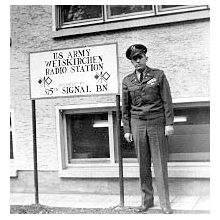 Bill passed away about 2 years ago in Lexington, Ky. I had been in touch with him and he even sent me copies of a proposed book he was writing. One chapter was devoted to his taking over the Battalion and making it military ready. The second one will be of Saikley, the only picture the webmaster could find. On the previous 102d website, they had all of the commanders from day one but the one of Saikley was provided to them by me. Unfortunately it was not of Saikley alone, it included me when I received Soldier of the Month award for May, 1958. 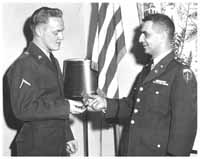
|
|||||||||||||||||||||||||||||||||||||
|
|
|||||||||||||||||||||||||||||||||||||
| (Source: Wesley Hall, Co E, 102nd Sig Bn, Königstuhl, 1957-59) | |||||||||||||||||||||||||||||||||||||
| I was a microwave radio repairman stationed in Konigstuhl from July 1957 to June 1959. Enclosed are some photos I took during my memorable stay in Germany. | |||||||||||||||||||||||||||||||||||||
|
|||||||||||||||||||||||||||||||||||||
|
|||||||||||||||||||||||||||||||||||||
| CHRISTMAS 1957 | |||||||||||||||||||||||||||||||||||||
| (Source: Wesley Hall, Co E, 102nd Sig Bn, Königstuhl, 1957-59) | |||||||||||||||||||||||||||||||||||||
|
|||||||||||||||||||||||||||||||||||||
| 1959 | |||||||||||||||||||||||||||||||||||||
| (Source: Lowell Haggard, Co E, 102nd Sig Bn, Königstuhl, 1959-61) | |||||||||||||||||||||||||||||||||||||
|
|||||||||||||||||||||||||||||||||||||
|
|
|||||||||||||||||||||||||||||||||||||
| 447th Signal Battalion | |||||||||||||||||||||||||||||||||||||
| 1971 | |||||||||||||||||||||||||||||||||||||
| (Source: STARS & STRIPES, June 11, 1971) | |||||||||||||||||||||||||||||||||||||
| The Koenigstuhl radio relay site is operated by a 28-man detachment of C Company, 447th Sig Bn, Karlsruhe. Site chief is M. Sgt Floyd R. Charlton. The radio site handles 616 circuits. Up to 60 individual military phone calls, except local ones, can be grouped together by multiplexers on one circuit and beamed to the next relay or terminal site. At the destination site, the individual calls are unscrambled again using the same process with which they were put together. Single troops are billeted at the site; married personnel live at Patrick Henry Village in Heidelberg. The site has a small movie theater and PX. |
|||||||||||||||||||||||||||||||||||||
| 1975 | |||||||||||||||||||||||||||||||||||||
| (Source: STARS & STRIPES, April 9, 1975) | |||||||||||||||||||||||||||||||||||||
| The Army is constructing a new concrete 189-foot television tower atop the Koenigstuhl. It will be capable of supporting 40 microwave antennas. The tower is being built as part of Phase III of the Scope Picture project. The new tower, the first Army-owned concrete TV tower in Germany, replaces two steel towers previously used on the 1,500-foot hill. In addition to provising AFNTV signals for eight military communities, the tower will also send microwave beams to all military installations south and south east of Heidelberg. |
|||||||||||||||||||||||||||||||||||||
| 43rd Signal Battalion | |||||||||||||||||||||||||||||||||||||
 Site map, Heidelberg ASG website, 2005 |
|||||||||||||||||||||||||||||||||||||
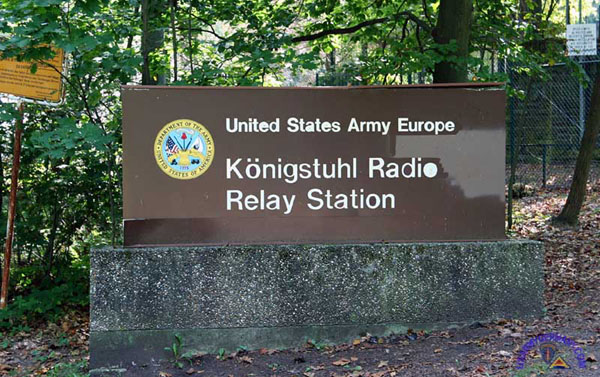 Sign in front of main gate, 1990's |
|||||||||||||||||||||||||||||||||||||
| 1980 | |||||||||||||||||||||||||||||||||||||
| (Source: Email from Jeff Zabriskie) | |||||||||||||||||||||||||||||||||||||
| I was a 26V20 Microwave Repairman. Served first at Namsan (Seoul), Korea 77-78, and then was stuck in Ft. Hood until I volunteered for Germany. I had DEB training for 3 months in Ft. Gordon and was assigned to the 181st Sig. Co. (Heidelberg) at KSL.
We single solders lived full-time at KSL, about 10, maybe a little more. The mess hall had rooms on the top floor and the barracks next to Opns had 2 floors. All nice rooms. |
|||||||||||||||||||||||||||||||||||||
|
|||||||||||||||||||||||||||||||||||||
The mess hall had two sets of German civilian cooks. Al and Else Pfeiffer, worked as maid and butler to the McGraw family in the US before returning to Germany to cook for us. They treated us GIs like family and remained friends years after I left the service. I can't say if the cement KSL tower was completely for DEB. I found some other sources I'll have to look around and get back to you on that. It was the first continuously poured cement tower in Germany but was there before I arrived. The cement stairs went up the inside and to get out onto a level was a steel door like a on a ship. When the wind blew, you could feel the tower move if you dared to go up very high. Your 1960's pictures answer a lot of questions about old tower locations. I never knew there were that many towers, thats why all the cement footings I found never made a lot of sense. I never mapped out the antennas completely as the forest blocked almost half of the tower from the ground. The big Andrews were for DEB's FRC-162's and the slightly smaller for FRC-80's. The 162's were dual diversity, so 2 were actively receiving and 1 was transmitting. We had a GRC-66 with a power amp that shot to Frankfurt. The Siemens-Halske shot was to Worms. We had frequent tactical visitors when it was training time and I think they just left the antennas up there. I don't remember much about them. We were also the helicopter pad for foggy nights when the Generals could not land their birds down near Heidelberg. I'll bet we had 20 acres of prime forest land. I left the Army in 1980 but stayed in Germany for another nine years, first working for Federal Electric who was the AMSF contractor for many years. I specialized in the DEB equipment for about 3 years so I visited every 162/5 in Europe, even a pair that were secretly in Berlin. I spent about a years as a civilian at the Augsburg listening station as they had a FRC 162 shot back to Augsburg. From FEC I moved away from microwaves on to tempest word processors, and then computers with a small firm called SESI. |
|||||||||||||||||||||||||||||||||||||
|
|||||||||||||||||||||||||||||||||||||



